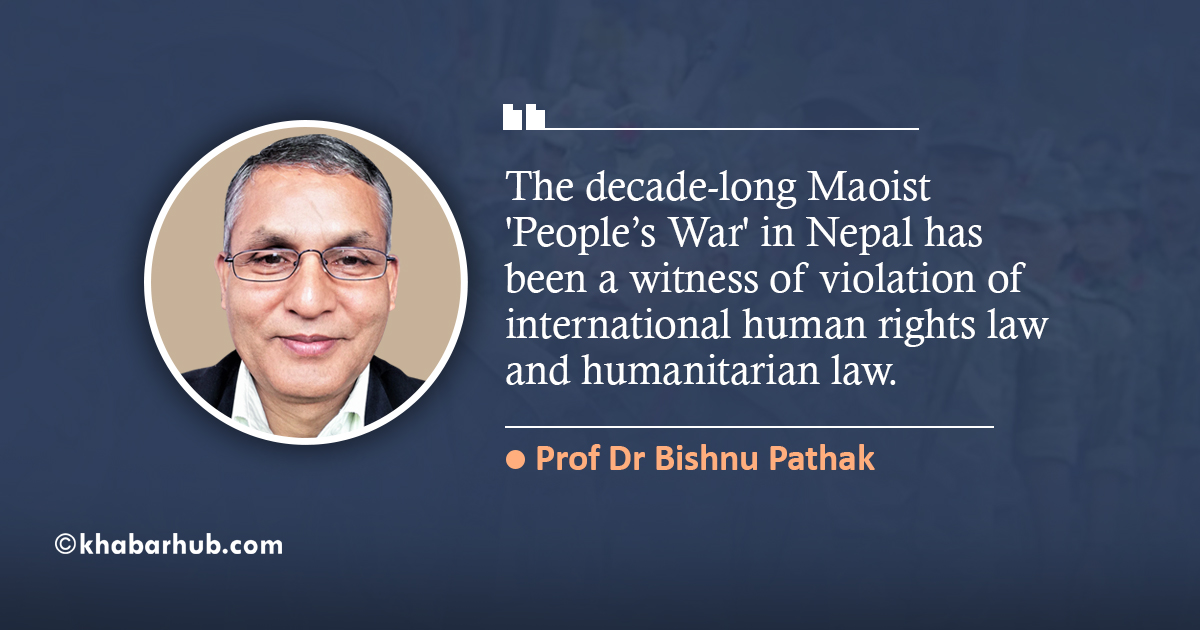Acceptance of the Court’s Jurisdiction: The Rome Statute shall also be effective once the non-State Party accepts its Article 12(3)’s jurisdiction.
The Government of Ukraine accepted the Court’s jurisdiction through the first declaration in April 2014 and second declaration in September 2015 over alleged crimes committed on its territory Crimea and eastern Ukraine from November 21, 2013, onwards. The preliminary examination continues there.
Similarly, the Palestinian Government lodged a declaration accepting the jurisdiction of the ICC acts committed on its territory. The Prosecutor initiated a preliminary examination of a reasonable basis for investigation and report submitted at the Pre-Trial Chamber.
A decade long (1996-2006) People’s War adversely left great impacts on political, legal, economic and societal dimensions.
But, the Chamber stopped the examination stating there had been a lack of jurisdiction.
A decade-long (February 1996-November 2006) Maoist ‘People’s War’ in Nepal has been a witness of violation of international human rights law and humanitarian law.
On July 24, 2006, Nepalese House of Representatives unanimously issued a Sankalpa Prastap (commitment resolution) which directed the Government to proceed ahead to ratify the Rome Statute. However, the result of ratification is yet to be completed.
Criteria of Court’s Admissibility
The examples above illustrate that the ICC establishment under the Statute shall be complementary to national criminal (issue-matter, territorial/personal and temporal) jurisdictions. It ensures justice to victims or survivors and prosecutes to the perpetrators.
The Prosecutor may open an investigation under four criteria (circumstances): (i) if the State becomes a Party to the Rome Statute; (ii) if the State Party shall accept the jurisdiction of the Statute; (iii) if the Security Council refers a situation to the ICC; and (iv) if the Pre-Trial Chamber authorizes the prosecutor to open an investigation on complaint registration by the victim/representative or NGO.
Former child soldiers in Nepal
The CPN (Maoist) initiated the ‘People’s War’ on February 13, 1996, with the objective for sweeping away the constitutional monarchy, bureaucratic capitalism, feudalistic mode of society, and historical roots of social inequality to establish a patriotic, democratic, progressive and prosperous People’s Republic of Nepal.
A decade-long (1996-2006) People’s War adversely left great impacts on political, legal, economic and societal dimensions.
About 20,000 people were extrajudicially killed; more than 3,000 people were involuntarily disappeared; thousands were indiscriminately injured, made disabled and single women; there are no records of arbitrary arrest, detention, torture, and rapes; and tens of thousands were internally displaced and among several other damages.
The signing of the Comprehensive Peace Accord between the Government of Nepal and the CPN (Maoist) on November 21, 2006, finally concluded the decade-long Nepalese civil war. Following the request for assistance of Nepal, the UN Security Council deployed the political mission named United Nations Mission in Nepal (UNMIN).
About one-third of the total numbers of those child soldiers were female. Almost all discharged were above 18 years.
The objective of UNMIN was to assist in creating a conducive environment for free, fair and impartial Constituent Assembly elections and to complete the transitional justice by disarming, demobilizing, reinserting, integrating (into state security forces-society) and rehabilitating (into society-family) to the combatants of the Maoist Army (MA).
The UNMIN served in Nepal from January 23, 2007, to January 15, 2011 (for 3 years, 11 months and 3 weeks). The UNMIN had initially registered 32,250 MA combatants but only 19,602 (61%) were verified, comprising 4,008 minors and late recruits stationed in 7 main and 21 satellite cantonments.
The UNMIN decided disqualified combatants, ie, Verified Minors and Late Recruits (VMLRs or child soldiers) discharged from temporary cantonments in Nepal on the witness of Special Representative of the Secretary-General for Children and Armed Conflict Radhika Coomaraswamy.
The first group of VMLRs was initiated from the cantonment in Sindhuli on January 7, 2011, and completed in a month. Each child soldier received Rs.10,000 by UN and Rs. 12,000 from the Maoist Party as transportation and transition allowances.
About one-third of the total numbers of those child soldiers were female. Almost all discharged were above 18 years.
Many discharged combatants had thrown their garlands in front of Maoist supremo Prachanda, UN representatives and other diplomats on February 8, 2010, the concluding day of the ceremony at Dahaban in Rolpa district.
The then Government of Nepal did not provide any package for their livelihood. The Maoist party, on the other hand, might think that once they received a handsome resettlement package, they would either initiate their normal life or might work with other parties too.
The rehabilitation packages for the reintegration of child soldiers were supported by the UN Integration Rehabilitation Program (IRP), Nepal. The rehabilitation package included formal schooling, vocational training, training as health workers and setting up small/micro-enterprises.
By November 2010, a total of 2,225 discharged former child soldiers were counseled under the packages. A large number of discharged allegedly said that they received the worth of NRs. 40,000 materials after training though the UN had allocated NRs 400,000 to each child soldier.
On February 10, 2011, the UN office at Dhangadi, Kailali district, the far-western region was vandalized by the discharged disgruntled child soldier on the charge of corruption on the food they were consuming and accommodation during skill-oriented training. The discharged child soldier reached their heart-broken and conflict victim families with an empty stomach.
(To be continued…)
Views expressed in this article are the author’s own and do not necessarily reflect the stance of Khabarhub.









Comment